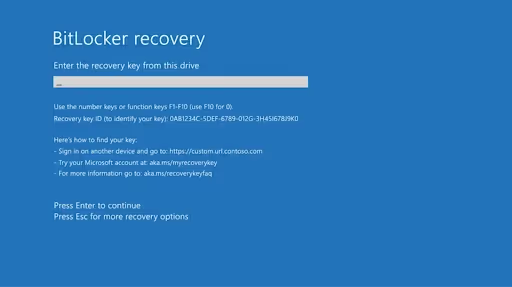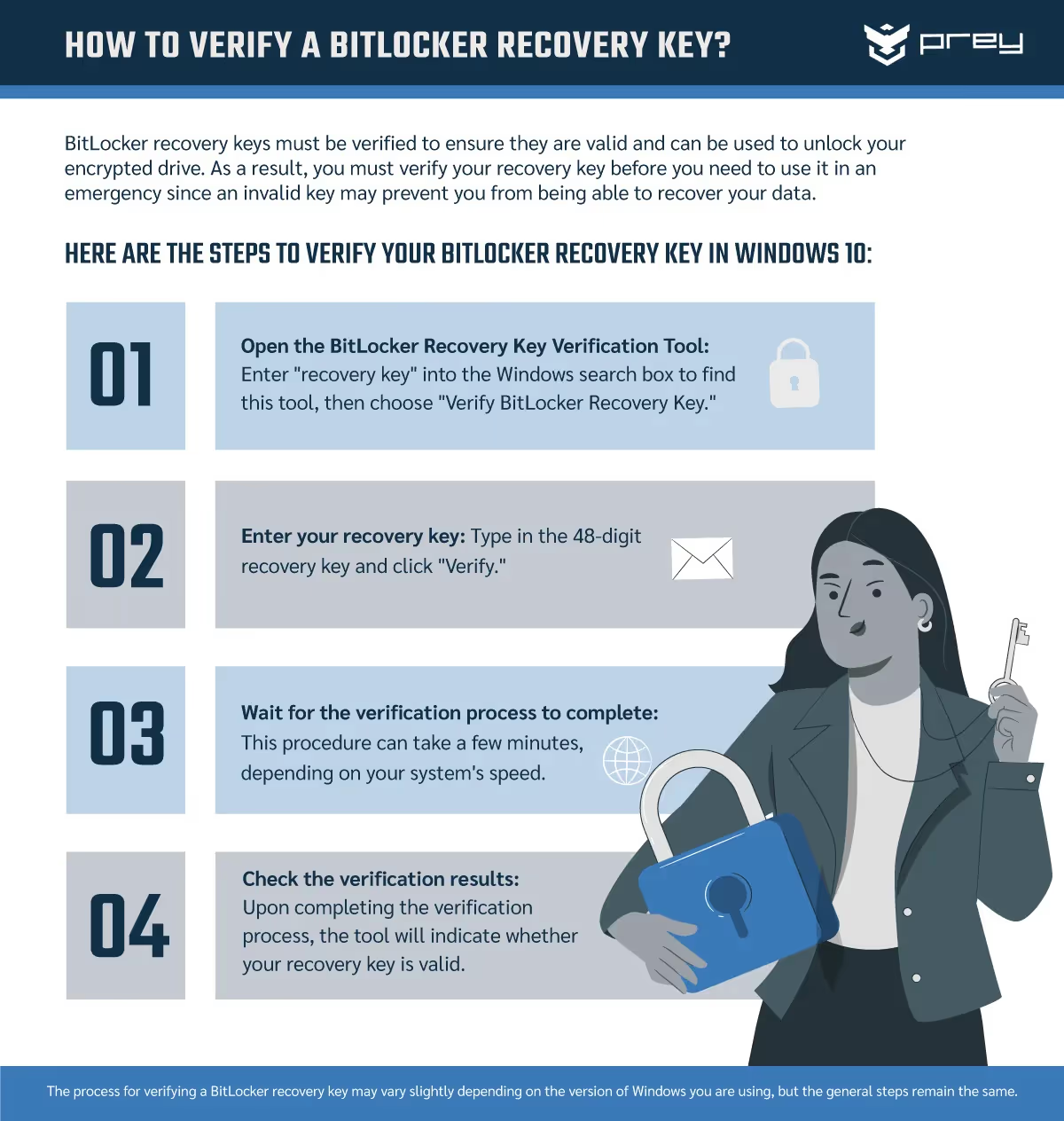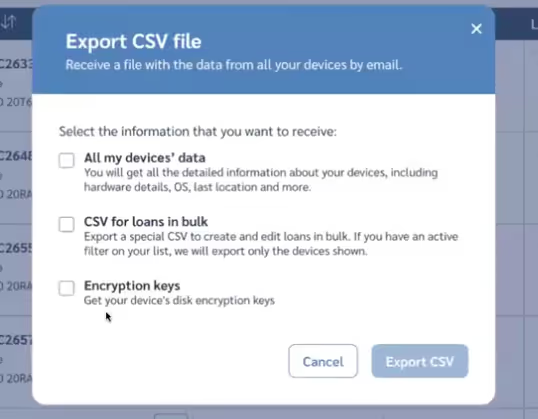Device encryption is no longer just a luxury—it’s a necessity. Whether you’re protecting personal files or sensitive company information, tools like BitLocker encryption are your first line of defense for windows devices.
Managing and retrieving data encryption keys, such as the BitLocker key, is crucial for maintaining access to your encrypted data. But what happens when you’re locked out of your own encrypted device? That’s where the BitLocker recovery key comes in—a vital safeguard that ensures you can access your data even when the unexpected happens.
In this guide, we’ll break down everything you need to know about the recovery keys: what it is, why it matters, and, most importantly, how to find it when you need it most. Let’s dive in and make sure you’re prepared for any data security hiccup.
According to the official Microsoft definition, your recovery key is a unique 48-digit numerical password that can be used to unlock your system if BitLocker is otherwise unable to confirm for certain that the attempt to access the system drive is authorized.
In other words, it is a password. A long and somewhat complicated password that you will not want to try and commit to memory. This recovery key is issued at the time of BitLocker installation in the event that the user forgets or misplaces their password and loses access to their hard drive.
BitLocker and its purpose
BitLocker is a full-volume encryption feature built into the Windows operating system. Its primary purpose is to protect data by encrypting the entire drive, ensuring that even if someone gains unauthorized access to the computer, they won’t be able to access the files without the decryption key.
How do you find your BitLocker recovery key?
Losing access to your encrypted data can feel overwhelming, but your BitLocker recovery key is the solution to unlocking it securely. Think of this key as a digital passcode—a unique, 48-digit safeguard created when BitLocker was activated on your device. Without it, your data remains locked, inaccessible, and safe from unauthorized access.
But where do you find this crucial key? Here's a quick overview of the process to guide you before we dive into specific locations:
Step 1: Understand what you're looking for
Your BitLocker recovery key is typically a long string of numbers, either saved digitally or stored physically. You might have received it when you first set up BitLocker encryption. Start by recalling how and where your device was set up—this can often provide clues about its storage.

Step 2: Narrow down common storage locations
Think about where your key might have been stored. Common options include:
- Your Microsoft account (accessible online if you signed in when setting up BitLocker).
- A printed copy stored in a safe place.
- A USB flash drive containing the key.
- For work related endpoints, IT department may be using some remote encription tools like Prey, try to contact them via your help desk option.
Step 3: Proceed with finding your key
Once you're ready, we'll take you step-by-step through the most common methods to locate your recovery key. From checking your Microsoft account to contacting your IT team, these solutions ensure that no stone is left unturned.
In the next section, we'll break down each location in detail to help you find your BitLocker recovery key quickly and securely.
How to verify a BitLocker recovery key?
BitLocker recovery keys must be verified to ensure they are valid and can be used to unlock your encrypted drive. As a result, you must verify your recovery key before you need to use it in an emergency since an invalid key may prevent you from being able to recover your data.
Here are the steps to verify your BitLocker recovery key in Windows 10:
- Open the BitLocker Recovery Key Verification Tool: Enter "recovery key" into the Windows search box to find this tool, then choose "Verify BitLocker Recovery Key."
- Enter your recovery key: Type in the 48-digit recovery key and click "Verify."
- Wait for the verification process to complete: This procedure can take a few minutes, depending on your system's speed.
- Check the verification results: Upon completing the verification process, the tool will indicate whether your recovery key is valid.
The process for verifying a BitLocker recovery key may vary slightly depending on the version of Windows you are using, but the general steps remain the same.

How to store a BitLocker Recovery Key?
Once you have your BitLocker Recovery Key in hand, here are some good storage ideas for all types of encryption keys you may need to access in the future.
1. Print it out and file it
- Record the key in a document and print it out
- Store it in an old-fashioned filing cabinet
2. Store it on a separate device
- Print your BitLocker Recovery Key as a PDF
- Store that PDF file on a separate computer
3. Put it on a USB flash drive
- Create a file with your BitLocker Recovery Key or print it as a PDF
- Store the USB drive in a safe or other secure location with other sensitive items and documents
4. For IT teams: Using Prey as your recovery key administrator
- When you activate Bitlocker, Prey will generate the recovery key for you and store it (also encripted)
- In case you need to manage all your end user devices keys, simply export in a CSV file to view bitlocker keys

By following any of these tactics to backup your recovery key, you will be setting yourself up for success. Printing or storing your key in a USB flash drive is the only way to find your Bitlocker recovery key without having access to your Microsoft Account.
Old-school but effective fixes to find your BitLocker recovery key
One thing to remember — besides trying to store your encryption keys in a logical place that you'll recall in an emergency — is that even when things look quite bleak, all may not be lost. In fact, there are a couple of simple, old-school remedies to give it one last shot if you are currently looking at the blue BitLocker recovery screen with no recovery key in sight.
Reboot your computer
Yes. If you have heard this once, you have heard it a thousand times from IT professionals, but it really does work (sometimes) in this specific case.
- Simply turn your computer off and back on again
- In a lot of instances, your laptop or PC might have reacted to what you could call a false positive if it thought there was a security issue that was not there
- Rebooting will give the startup process and protocols another run-through, and you may be able just to enter your regular password or PIN and go on with your day
BIOS changes
If you are an IT pro or just someone who knows enough to be reckless, something you have done to your drive or device may have triggered a security protocol, i.e., BitLocker.
- If you changed something in your BIOS or moved some hardware about, just go ahead and change it back
- You may have to restart your computer to reactivate BitLocker and trigger the false positive
Troubleshooting BitLocker Recovery Issues
The BitLocker recovery screen is a security measure that appears when BitLocker is unable to automatically unlock an encrypted drive. This screen prompts the user to enter a 48-digit recovery key, which is used to regain access to the encrypted data. The recovery screen may appear due to various scenarios, such as hardware changes, software updates, BIOS changes, or a simple system glitch.
If you’re experiencing issues with the BitLocker recovery screen, there are several troubleshooting steps you can take:
- Check your Microsoft account: If you’ve stored your recovery key in your personal Microsoft account, try accessing it from another device. Log in to your account and navigate to the BitLocker recovery keys section to find your key.
- Verify your recovery key ID: Ensure that you’re using the correct recovery key ID, which can be found on the BitLocker recovery screen. Match this ID with the one listed in your Microsoft account or other storage locations to confirm you have the right key.
- Check your USB flash drive: If you’ve saved your recovery key on a USB flash drive, try plugging it into your locked device. Make sure the USB drive is properly connected and recognized by the system.
- Contact your IT department: If you’re part of an organization, reach out to your IT department for assistance with retrieving your recovery key. They may have a copy of the key stored in Active Directory, Prey or another secure location.
- Reset your device: As a last resort, you may need to reset your device using one of the Windows recovery options. However, this will remove all of your files, so be sure to back up your data before doing so.
Next steps
Data security isn't just about protecting devices—it's about protecting the trust that your organization, team, or even family places in their technology every day. BitLocker provides a solid first layer of defense, keeping your sensitive information safe from prying eyes. But to truly get the most out of it, you need to pair it with smart practices, like securely storing your recovery key, and effective tools that make managing encryption effortless.
At Prey, we know how overwhelming data security can seem, especially when you're managing multiple devices or responding to unexpected incidents. That's why our Disk Encryption solution is designed to work seamlessly with tools like BitLocker, adding extra layers of control and automation to make your life easier.
Here's what it can do for you:
- Peace of Mind: Encrypt all disks and drives with a few clicks, ensuring your data stays protected wherever your devices go.
- Proactive Protection: Automate security responses, like locking devices when they leave designated safe zones.
- Stay Compliant: Easily meet data protection standards like ISO, HIPAA, and GDPR without extra hassle.
- Bitlocker recovery keys management: For windows devices (TPM enabled), Prey can activate bitlocker capabilities, store and manage the recovery keys for troubleshooting.
- Flexibility for Your Workflow: Schedule actions like device locks or security curfews, so you're always a step ahead.
Securing your data shouldn't feel like a chore—it should feel like the assurance that no matter what happens, you've got things under control. With Prey's Disk Encryption, your team can focus on what matters most, knowing that their data is safe.
FAQs
1. How do I enter the Bitlocker recovery key?
Once you're prompted to provide the Bitlocker recovery key, you should type in the 48-digit key exactly as it appears. It's important to note that you must enter the key on the same device where the drive was encrypted. It won't work if you try to enter the recovery key on another device. If you have the key saved as a file or printout, simply type it in when prompted.
2. How do I get out of Bitlocker recovery?
To exit the Bitlocker recovery screen, you need to provide the correct Bitlocker recovery key. Once you've entered the recovery key, your device should resume normal operation. If you're stuck in a loop where you're continually asked for the recovery key every time you start up your device, there could be a hardware or software problem. In this case, it's best to consult with a professional or contact Microsoft support for assistance.
3. Is there a Bitlocker recovery key generator?
No, there isn't a Bitlocker recovery key generator. A Bitlocker recovery key is a unique 48-digit numerical password that's generated when you turn on Bitlocker Drive Encryption for the first time. It's not something that can be generated or retrieved through a third-party tool or software. It's important to keep a safe copy of your recovery key in case you need it to unlock your Bitlocker-encrypted drive.
4. How do I unlock my Bitlocker recovery key?
You don't unlock the recovery key itself, rather you use the Bitlocker recovery key to unlock your Bitlocker-encrypted drive. When you're prompted by Bitlocker for the recovery key, enter the 48-digit recovery key exactly as it is. After the key is validated, your drive will be unlocked and you'll be able to access your data.
5. What happens if you have a lost Bitlocker recovery key?
If you can't find your Bitlocker recovery key and you're unable to access your drive, unfortunately, there's little you can do. The Bitlocker recovery key is designed to be a last resort for accessing your data, and if it's lost, the data on your drive may be irretrievable. Microsoft does not store personal recovery keys and cannot help you recover them if lost. Therefore, it's critical to keep a copy of your recovery key in a safe and accessible location.





